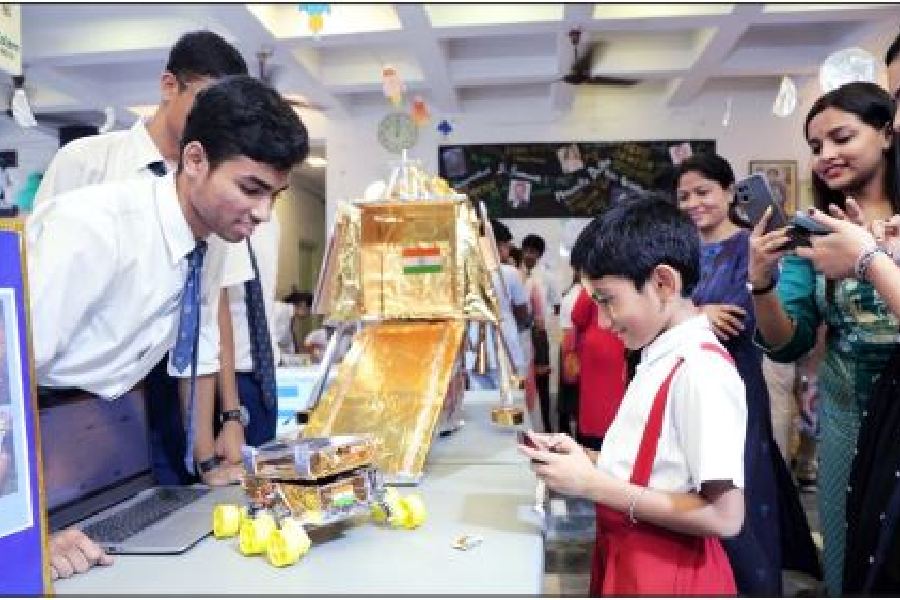The physics and robotics exhibition at St. Joan’s School this time was dedicated to the Indian Space Research Organisation (Isro). Named Exoergic 2k23, the event aimed to instill a scientific temper within diligent students, nurturing their proficiency in STEM (science, technology, engineering and management) subjects.
Before our vacations, Google forms were circulated among us students, seeking proposals. This led to brainstorming sessions, formation of groups, and seeking of guidance from teachers.
I formed a team with Soumarya Pal, Souhitya Paul and Preet Bararia, and worked on a project related to tesseract and plasma-cutting, with applications in metallurgy. We named the project Danger City. Our prototype utilised high-voltage arcs for easy cutting and welding of metals. We worked tirelessly, meeting during and after school hours, and all participants shared a similar level of dedication to make the project as appealing as possible.
Bright minds
To accommodate all the projects, both the assembly hall and the robotics lab were used. As the exhibition day approached, the entire school was filled with anticipation and excitement.
The seniors took charge of decorating the school assembly hall on an Isro theme, paying homage to our recent scientific achievement, Chandrayaan 3.
On the day of the exhibition, our school had invited Radha Raman Pal, head of the physics department at Vidyasagar University, Prof Mahendra Nath Sinha Roy, who is a PhD from the University of Adelaide, Australia, and Sourav Chatterjee, a research engineer at TCS research and innovation, Calcutta, incubating quantum technologies.
Chatterjee happens to be an alumnus of St Joan’s 2005 batch. He has also worked as a senior scientist in Quantum Experiments with Satellite Technology (QuEST) project at the Raman Research Institute (RRI) and ISRO. Before this, he was senior scientist at the Quantum Experiments with Satellite Technology (QuEST) project at the Raman Research Institute and Isro.
Their presence inspired curiosity and passion in the hearts of students.
“It was a great experience to spend a day with you students and witness these magnificent science models,” he remarked. “Every project, from conception to the presentation, was well-executed and reflected the high quality of teaching at the school,” said Pal.
He also offered suggestions for future projects, like smart water supply in plants and automatic water level controller for overhead tanks using Arduino (an open-source hardware and software company, that manufactures single-board microcontrollers and microcontroller kits for building digital devices), a musical doorbell, and constant current driver for LED lights.
Space exploration
That the Pragyan rover had captured the imagination of millions, was clear when Class XII students Joyobrata Das, Anubhab Mondal, Rishav Mondal, Medha Saha and Oishani Das built a replica of the same. “What makes this model captivating is that it brings the wonders of space exploration onto our school premises,” one of them said.
Visitors to our exhibition could get up close to the engineering marvel and watch the precision of its movements, and the scientific instruments it carries on board. The model was a fully functional replica.
Aryan Roy, Fahim Aziz Munshi, Sneha Sutradhar and Anushka Pal of Class IX created an automatic railway gate system that used robotics to detect obstacles and automate railway gate operations. It was based on the Arduino Uno microcontroller and utilised principles of artificial intelligence and robotics.
Suryasish Saha, Souraj Kundu, Zishan Aris, Naina Nahata and Trisha Mondal of Class IX worked on light fidelity, that used light for fast data transmission. “Li-Fi uses light as a medium of data transmission for faster, safer, and efficient communication. Despite facing a momentary setback during our demonstration,we regained our confidence and successfully presented our project,” the team members said.
In a traditional setting, parents would be teaching children, but at this exhibition, a role reversal of sorts took place, with children enlightening their parents about the latest technologies. The parents too developed new-found respect for the students.
Exoergic 2k23 brought together students, teachers, parents, and the wider community to explore the wonders of the physical world. It nurtured curiosity, sparked innovation, and reminded us that the pursuit of knowledge is but a lifelong adventure.
